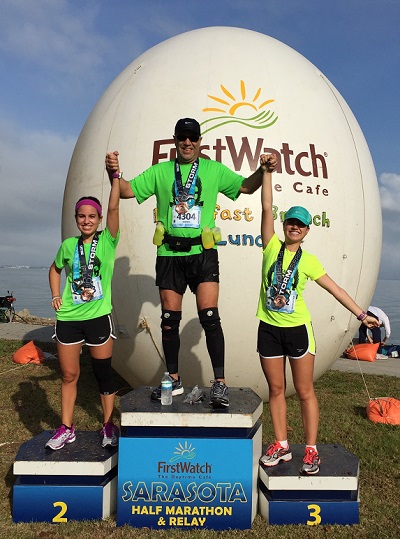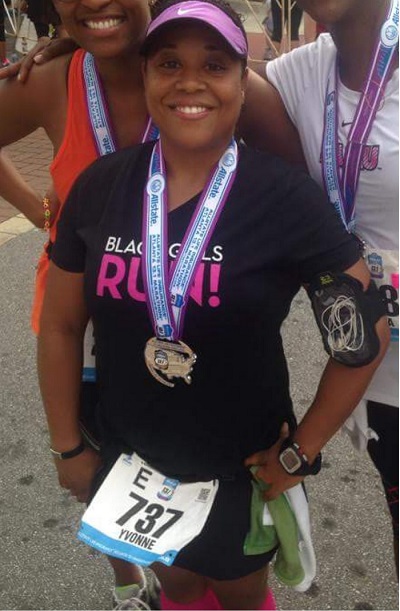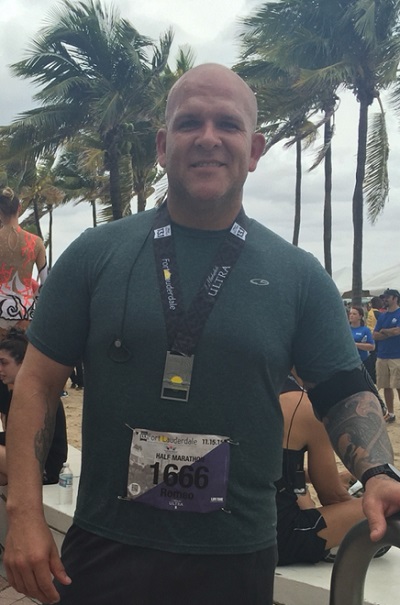March 27, 2020 by John Fernandez
Marathon Profiles 2016: Why They Run (Part III)

(This is the third and final post in a series of articles focusing on runners taking part in the Miami Marathon and Half Marathon on January 24. Baptist Health is a sponsor and the official medical provider for the event.)
Javier Salmon, 59:
“I said ‘you know what? I can do this.’”
 Javier Salmon is running for his life. Salmon, who is preparing for the Miami Marathon January 24, will tell you that since his two daughters convinced him to take up running three years ago at the age of 56, his life has been transformed in ways he could not have imagined. Running made the difference, he says and if he can do it, you can do it.
Javier Salmon is running for his life. Salmon, who is preparing for the Miami Marathon January 24, will tell you that since his two daughters convinced him to take up running three years ago at the age of 56, his life has been transformed in ways he could not have imagined. Running made the difference, he says and if he can do it, you can do it.
Salmon, who is running the full 26.2 miles, is one of 25,000 people who will run either a full marathon or half marathon at Miami’s 14th annual event, beginning at 6 a.m. Each person had a unique journey that prepared him or her to take on a challenge that most people would not consider. Many had health, fitness and weight loss goals. Some are survivors of cancer or people with disabilities. Others were looking for a sense of community, or were on a mission to relieve stress or prove what they’re made of – to themselves and to people who may have counted them out.
The running community is close-knit. They say there’s nothing like the support and encouragement they receive from fellow runners, who know what it’s like to change a life for the better and help others reach their goals.
No one is a more eloquent motivator than Salmon. When his daughters, Ariana, 24, and Anelize, 22, (pictured above with their father) began asking him to run with them on Saturday mornings, he was active — but 30 pounds overweight. Even though he finally said yes, he thought running was for younger people. They arrived in Coconut Grove at about 6 a.m., where he saw people of every age from teens to “older fellows like me.” They arrived in time to hear a pre-run pep talk, which included information about the day’s run – six miles.
“That sounded to me like from here to Ecuador,” he says. “There was a group of older ladies there, and I said if they can do six miles I probably can hold.” One of the women, who heard his hesitation, invited him to follow them, and do a walk/run.
“It took an hour and a half to almost two hours, and I did six miles,” he says. “I said ‘you know what? I can do this.’”
These days, he says, he rises between 4 and 5 a.m. on Saturdays, looking forward to the run and catching up with his girls.
“When most families are heading out, and everybody’s doing their own thing, away from each other, I have the chance to run with my daughters.”
He also enjoys talking with “my running peeps”, members of the running community, including co-founder of the marathon Frankie Ruiz, who provide support, friendship and understanding of the running life.
Transforming the mind and body to become a marathon runner doesn’t happen overnight, he says. “It’s a process, something you develop little by little.”
“You begin to develop the stamina. Then the stamina begins to develop the heart, and the heart begins to develop your mental attitude to get there.”
“If you’d like to become a runner,” Salmon says, “you need to become disciplined. Discipline brings commitment, and that’s something that trickles into your life” he says. “It’s not just running. It’s everything you do.”
Yvonne Douglas , 37:
“My whole life I’ve been told you probably shouldn’t be doing this, and I’ve always exceeded it.”
 When Yvonne Douglas arrives in Miami from Atlanta for the Miami Marathon, it will be a homecoming for the Miami native in more ways than one. It was here that Douglas, now 37, became a marathon runner at 22, after a conversation with a fellow graduate school classmate at Florida International University, Ruiz, who was also developing the Miami Marathon.
When Yvonne Douglas arrives in Miami from Atlanta for the Miami Marathon, it will be a homecoming for the Miami native in more ways than one. It was here that Douglas, now 37, became a marathon runner at 22, after a conversation with a fellow graduate school classmate at Florida International University, Ruiz, who was also developing the Miami Marathon.
When he asked if she was a runner, she remembers proudly telling him that she did corporate runs.
“He was saying I’m planning this marathon. And he’s like ‘you should do it,’ and I’m like, ‘ I’m not doing a marathon.’ He said o.k., do a half. I just jumped in, and did the half in the first Miami Marathon.”
Not everyone would take on a 13-mile run based on a conversation, no matter how inspiring, but Douglas is not everybody.
“When I was born there were some developmental issues. I actually only have three fully developed toes. On my left foot I only have one toe, my pinky toe,” she says. “On my right foot I have my big toe and my pinky toe. And on my hands I only have one fully developed finger.”
“(Doctors) basically told my mom ‘your child may not be able to walk. She won’t be able to bathe herself and write’ and that’s clearly not the case. I do everything everybody else does. Monkey bars are the only thing I can’t do.”
In 2007, she moved to Atlanta. A member of one of the first graduating classes at MAST Academy on Key Biscayne, Douglas works for the Atlanta public school system as project manager, energy and environmental services, where her work includes environmental quality and developing green spaces.
Douglas, who is president of FIU’s Atlanta Alumni organization, says the adjustment to running the city’s hilly terrain was a tough one, but she mastered it. Then she accidentally slammed her foot against a wall, and “It just shattered, so the toes that I have had to be reformed.”
After reconstructive surgery in 2009, recovery and therapy, Douglas got back on the pavement in November 2010. During her recovery from surgery, she was diagnosed with hyperthyroidism, an auto-immune disorder that caused her to gain weight. Losing the weight has remained a struggle, she says, but she continues to run. She also became an active member of Black Girls RUN!, the national movement started in Atlanta in 2009, with a mission of encouraging African-American women to make fitness and healthy living a priority. The grassroots organization with chapters across America, hopes to lower the percentage of black women who are overweight and suffering from chronic diseases as a result of unhealthy diet and sedentary lifestyle.
According to the U.S. Centers for Disease Control, 80 percent of African-American women are overweight. The group now has 160,000 members, including members of Black Girls RUN! South Florida.
She is also a member of Half Fanatic, the international running group focused on half marathons. “I’m Half Fanatic, number 9,655.”
Douglas says she has three “running bucket list goals,” to run 50 half marathons in all 50 states, run another major U.S. city marathon, and a major marathon outside of the U.S.
However, after months of training, she’s focused on running the full Miami Marathon. Running, she says, is part of her drive to succeed.
“My whole life I’ve been told you probably shouldn’t be doing this, and I’ve always exceeded it,” Douglas says. “So this is just another example of that. I continue to strive, and do the best I can do.”
Romeo Urbina, 40:
“I don’t think there’s any drug in the world that could make you feel the energy I felt that day.”
 Although Romeo Urbina can lift 475-pound dead-lifts, a year ago he could not run more than a few miles without pain. That changed after a former girlfriend inspired him to look at fitness differently. A marathon runner who had run at least five marathons, she encouraged him to try it.
Although Romeo Urbina can lift 475-pound dead-lifts, a year ago he could not run more than a few miles without pain. That changed after a former girlfriend inspired him to look at fitness differently. A marathon runner who had run at least five marathons, she encouraged him to try it.
“I saw that energy,” Mr. Urbina says. “I don’t think there’s any drug in the world that could make you feel the energy I felt that day. It almost brings you to tears. It was very inspirational. I saw the energy and I started to soak in the possibilities of me actually being able to do a half marathon. I’d never run anything more than a mile and a half.”
In the beginning, Urbina says, it was slow progress. “I couldn’t seem to get past running three and a half miles. When I did, I would be in excruciating pain in my ankles, my knees. My body wasn’t used to it.”
However, Urbina began training for the Miami Marathon about seven months before the race, three months before the start of training season. In November, he completed his first half marathon in Ft. Lauderdale, but he didn’t stop there. In early December, he was preparing for two half marathons, followed by the full Miami Marathon.
Urbina says he received a lot of encouragement from fellow runners, both in-person and through social media. This year, Urbina is preparing to run a full marathon.
“Every Saturday, we have a training session,” he says. “That was the first time I actually did 18 miles. I joke around that I actually spoke to God that day… I almost threw in the towel.”
After completion of the half marathon, he says, the number of runners who continue for 26 miles drops significantly.
“I think it’s more mental… I’m going to be ready for it.”
Next to being the father of two girls, Meaghan, 7, and Mikeyla, 9, he says, the marathon is one of the biggest challenges he has ever given himself. Urbina says he is grateful for the ability to run.
“Just to have that privilege, and to prove to myself that I can… it’s a big chunk of my inspiration.”
top stories












There are no comments